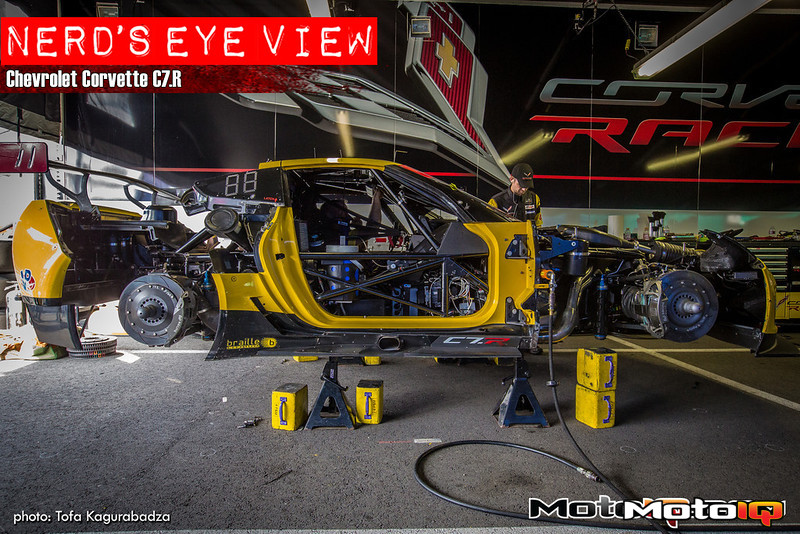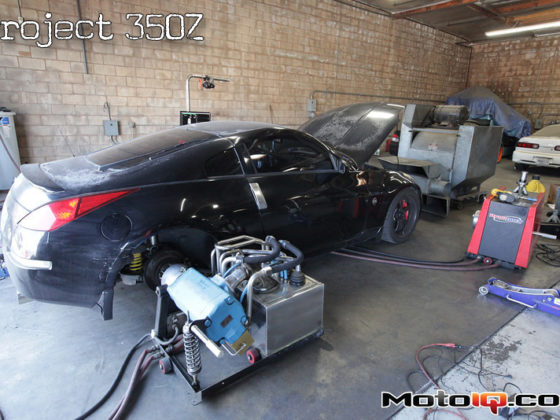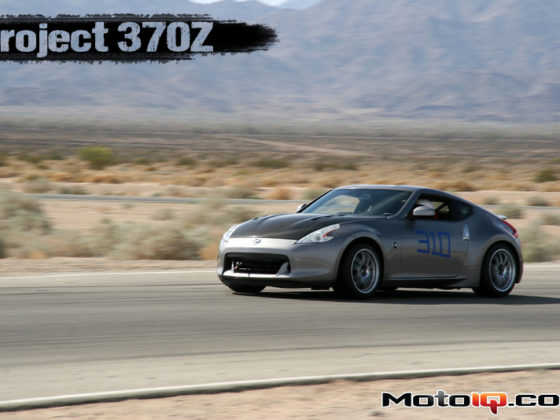,
 The AP Racing Radi-CAL is carved out for maximum weight reduction while still maintaining the required stiffness. A lot of FEA was involved in designing the calipers. Of course, sizably thick brake pads are used as the C7.R competes in endurance races.
The AP Racing Radi-CAL is carved out for maximum weight reduction while still maintaining the required stiffness. A lot of FEA was involved in designing the calipers. Of course, sizably thick brake pads are used as the C7.R competes in endurance races. About that aluminum frame… behind the heat shielding, you can see the grid texture on the cast aluminum component of the frame showing it is indeed production car based. The C7.R frame is some 40% stiffer than the C6.R and this increased stiffness was immediately noticed by the drivers. One thing the production car does not have, though it’d be awesome, is air jacks. You can see the air jack mounted to a bracket welded to the frame. The beautiful headers appear to be a tri-Y design and are tightly packaged as they wrap around the frame. Heat shielding is used to protect components in the vicinity of the headers.
About that aluminum frame… behind the heat shielding, you can see the grid texture on the cast aluminum component of the frame showing it is indeed production car based. The C7.R frame is some 40% stiffer than the C6.R and this increased stiffness was immediately noticed by the drivers. One thing the production car does not have, though it’d be awesome, is air jacks. You can see the air jack mounted to a bracket welded to the frame. The beautiful headers appear to be a tri-Y design and are tightly packaged as they wrap around the frame. Heat shielding is used to protect components in the vicinity of the headers. The new stiffer frame of the C7.R pays dividends when the drivers crash over bumps and curbing. From this view, you can also see the central hood vent which is ducted to the backside of the angled radiator.
The new stiffer frame of the C7.R pays dividends when the drivers crash over bumps and curbing. From this view, you can also see the central hood vent which is ducted to the backside of the angled radiator. Each header dumps out the side on top of the side sill. This prevents the exhaust flow from disrupting airflow underneath the car thereby reducing downforce generation. Something unique Corvette Racing has done has been to implement this extra protection on the driver’s side to help prevent the intrusion of objects from hitting the driver. The door bars will protect against large objects, like walls or other cars, but smaller objects like rods could potentially get to the driver without this extra protection in place. One major area of differentiation between the C7.R and the C6.R is the air ducting and flow management at the rear of the car. Here you can see large air scoops integrated into the front of the rear fenders grabbing large volumes of air. The C6.R used much smaller scoops combined with NACA ducts mounted on top of the rear fenders. While the C7 street car uses NACA ducts in the upper surface of the rear fenders, it was found that those NACA ducts disrupted the airflow to the rear wing of the race car reducing the efficiency of the wing. Therefore, the top mounted NACA ducts were eliminated leaving a smooth surface and these large side scoops employed instead.
Each header dumps out the side on top of the side sill. This prevents the exhaust flow from disrupting airflow underneath the car thereby reducing downforce generation. Something unique Corvette Racing has done has been to implement this extra protection on the driver’s side to help prevent the intrusion of objects from hitting the driver. The door bars will protect against large objects, like walls or other cars, but smaller objects like rods could potentially get to the driver without this extra protection in place. One major area of differentiation between the C7.R and the C6.R is the air ducting and flow management at the rear of the car. Here you can see large air scoops integrated into the front of the rear fenders grabbing large volumes of air. The C6.R used much smaller scoops combined with NACA ducts mounted on top of the rear fenders. While the C7 street car uses NACA ducts in the upper surface of the rear fenders, it was found that those NACA ducts disrupted the airflow to the rear wing of the race car reducing the efficiency of the wing. Therefore, the top mounted NACA ducts were eliminated leaving a smooth surface and these large side scoops employed instead. A portion of the air grabbed from the side scoop feeds the rear carbon fiber brake duct. As any type of race vehicle, the bolt connecting the upper suspension control arm to the rear upright is safety wired to prevent it loosening. A bolt falling out here would make for a very bad day with the car pulling multiple lateral Gs while closing in on 200mph.
A portion of the air grabbed from the side scoop feeds the rear carbon fiber brake duct. As any type of race vehicle, the bolt connecting the upper suspension control arm to the rear upright is safety wired to prevent it loosening. A bolt falling out here would make for a very bad day with the car pulling multiple lateral Gs while closing in on 200mph.


